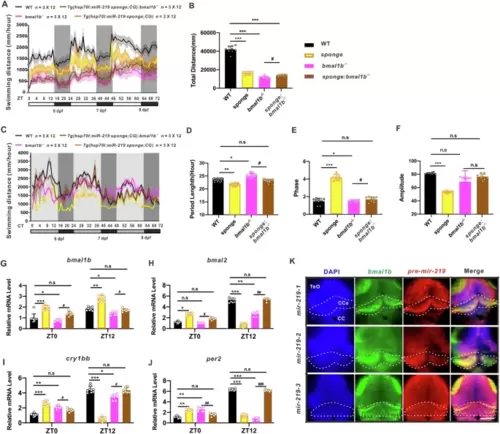Fig. 6
- ID
- ZDB-FIG-250124-54
- Publication
- Wu et al., 2024 - A miR-219-5p-bmal1b negative feedback loop contributes to circadian regulation in zebrafish
- Other Figures
- All Figure Page
- Back to All Figure Page
|
Loss of Bmal1b restores the circadian rhythm of Tg (hsp70l: miR-219 sponge; CG2) zebrafish larvae.Locomotor activities (A) and total swimming distances (B) of Tg(hsp70l:miR-219-5p sponge;CG2) (sponge) (yellow), bmal1b−/− (magenta), Tg(hsp70l:miR-219 sponge;CG2);bmal1b−/− (brown), and WT control (black) larvae under LD conditions. Data are mean ± SD. n = 3 × 12. Locomotor activities (C), period (D), phase (E), and amplitude (F) of Tg(hsp70l:miR-219 sponge;CG2) (sponge) (yellow), bmal1b−/− (magenta), Tg(hsp70l:miR-219 sponge;CG2);bmal1b−/− (brown), and WT control (black) larvae under DD conditions. Data are mean ± SD. n = 3 × 12. Expression of circadian clock genes bmal1b (G), bmal2 (H), per2 (J), and cry1bb (I) in Tg(hsp70l:miR-219 sponge;CG2) (sponge) (yellow), bmal1b−/− (magenta), Tg(hsp70l:miR-219 sponge;CG2);bmal1b−/− (brown), and WT (black) control larvae under DD conditions, as shown by qRT-PCR. Data are mean ± SD. n = 3 × 3. Unpaired two-tailed Student’s t-test was performed, *P < 0.05, **P < 0.01, *** P < 0.001 vs. WT; #P < 0.05, ##P < 0.01, ### P < 0.001 vs. bmal1b−/−. K Co-localization of bmal1b (green) with mir-219-1 (red), mir-219-2 (red), and mir-219-3 (red), primarily in Tectum opticum (TeO) (white), Corpus cerebelli (CCe) (yellow) and Crista cerellaris (CC)(orange), respectively, as shown by two-color FISH. The scale bar is 50 μm. n = 3 × 6. See also Fig. S10. |

